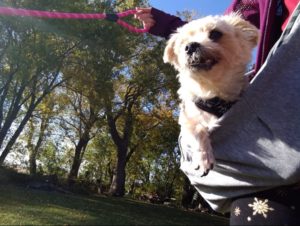First Aid – Safely Transporting an Injured Dog
2 min read If a dog has been injured and needs to be moved to assure its and your safety you will need to follow a few pointers to safely remove it from danger. You will need to first assess the injured dog’s injuries to determine how to keep from causing further damage.
If a dog has been injured and needs to be moved to assure its and your safety you will need to follow a few pointers to safely remove it from danger. You will need to first assess the injured dog’s injuries to determine how to keep from causing further damage.
A lot of severe injuries occur by dogs getting hit by vehicles. You will need to try to take the dog away from traffic or if it is walking or running, you might need to try to slow or stop traffic to keep the dog from becoming reinjured by a vehicle. Also, keep in mind an injured animal may bite so take precautions to prevent injury to yourself or others. A towel loosely wrapped around the muzzle, or even a shoestring will help keep the mouth closed dog slings for small dogs B083TX45MY.
Spinal and Head Trauma
A dog with a possible spinal injury or head trauma will exhibit the following signs: unconsciousness, different sized pupils, shock, blood in the ear, nose, mouth, or anus, and/or paralysis. If you suspect these types of injuries you will need to find an object with a solid, flat surface (such as plywood, a sled, or a stiff piece of cardboard) that is large enough that the entire animal can comfortably fit.
Gently ease the dog onto the top surface, making sure he is lying on his side. Try not to twist the dog’s body or neck as you move him. If you are unable to find a solid surface you can use a towel or blanket. Gently ease the dog onto the material. In both cases, try to secure help to transport the animal onto the surface and into your vehicle.
Pelvic and Leg Injuries
An injured dog with a pelvic fracture or leg injury may show the following signs: limping, swelling, or extreme pain. To safety transport the animal to the veterinarian’s office you will want to prevent further limb injury.
If the dog can stand, but doesn’t bear weight on the limb you can try to create a simple splint to prevent further swelling or dislocation of any broken bones in the leg. If the dog allows, you can gently wrap the leg in a large, folded towel to prevent bumping of the leg as the dog walks to your car. A towel can be placed under the stomach, and then you can hold the two ends above the back to make a sling to assist the dog in walking.
A dog with a fractured pelvis or one which is unable to stand should be transported as with a spinal or head trauma. Be extremely care